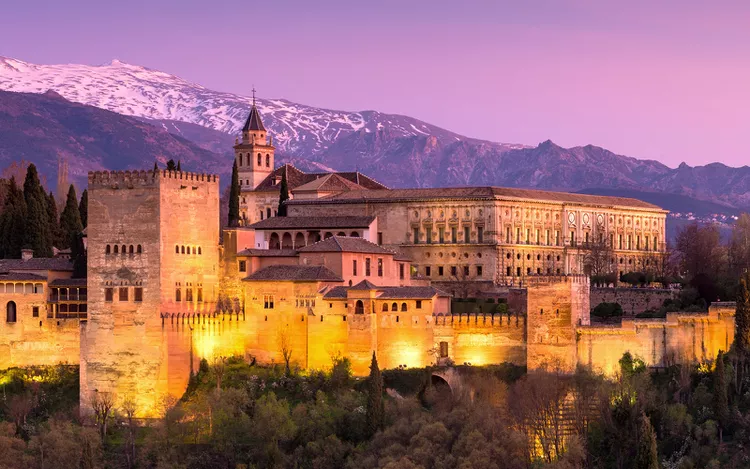Summary
On a foothill of the Sierra Nevada, in southern Spain, a mighty, 700-year-old citadel towers over the city of Granada.
Fact checked by Sarah Cahalan

Separate from the city of Granada itself, the famous Alhambra and all that it contains — royal halls and residences, brimming gardens, marble patios, and military barracks — have been a star attraction of the region for centuries.
Designated a UNESCO World Heritage Site in 1984, the Alhambra got its start under the Nasrid dynasty, the last line of Muslim sultans to rule over the Iberian Peninsula. With high ramparts that span a mile in circumference — not to mention 30 watchtowers and four nearly impenetrable gates — it’s endured countless sieges, demolitions, and additions over the years.
Even more breathtaking than the resilience of its walls is the depth of its history.
Historical Significance of the Alhambra
The Alhambra, which went up between the 13th and 14th centuries, is an exceptional testament to the art and architecture of that period. “People from Granada are very proud of the Alhambra and their city,” said Maria Valdecascas, who leads group and private tours to the site. “Every guest is brought to the Alhambra.” The residential Albayzín district is the best-preserved example of a Hispano-Muslim city in the South of Spain formed during the Nasrid dynasty.
Preserved Palatial City of Medieval Islam
The Nasrid Dynasty, which lasted from 1238 to 1492, marked the last period of Muslim rulers in Spain. Although the Alhambra had its origins as a ninth-century military fortress, it took several different sultans (particularly Muhammad I, Yusuf I, and Muhammad V) to effectively transform the site into the remarkable palace we know today.
Explore the Generalife
Generalife, a separate Nasrid estate, technically sits outside the Alhambra’s walls, but it’s linked through a series of ornamental gardens with long patios and flowing water channels — ranking it high on horticulturists’ lists when they visit Granada. More rural than the Alhambra, Generalife’s baroque courtyards overlook multiple vegetable gardens, and there is also a palace, built in the same architectural style as the Alhambra.
Importance of Water in Construction
It’s no accident that the Alhambra was built just over three miles from a major river. This location was crucial to supply water for the bubbling fountains, rectangular pools, and marble baths around which each section of the palace was organized. Additionally, the lush flowerbeds and abundant greenery required watering, so run-off from the fountains was used as effective irrigation.
Contributions from Spanish Rulers
In addition to the celebrated Comares Palace, the Palace of the Lions, and the Partal Palace, there’s a fourth — and equally spectacular — palace inside the Alhambra. Commissioned by Emperor Charles V, one of the region’s first Christian rulers after the Nasrid dynasty, the Renaissance-style Palace of Charles V features an extensive circular courtyard that’s about 100 feet in diameter and framed by a portico with 32 stone columns.
Art Integrated in Architecture
Unlike other museum estates in Europe, you won’t find framed portraits or objects in glass cases at the Alhambra. Here, the “art” is built directly into the walls, ceilings, window frames, and floors. Throughout each of the palaces, you’ll marvel at carved stucco panels inscribed with Arabic poetry. Bold squares of colored tile work play out dramatically, reminiscent of a vibrant Technicolor movie poster. When you meander through the covered patio of the Palace of the Lions — where slender, carved columns rise from the ground like ivory saplings — you’ll truly appreciate this unique form of artistic expression.
Continuous Restoration Efforts
Conservation and restoration work is always ongoing at the Alhambra, so revisiting year after year reveals new features to admire. For example, the famous Lions Courtyard — showcasing a fountain with 12 separate lion statues that spout water from their mouths — underwent restoration in the early 2000s, a process that took eight years.
None of the renovations, however, have impeded the annual International Festival of Music and Dance that takes place at the palace each summer. Drawing an international roster of artists, the Palace of Charles V and the open-air theater of Generalife serve as remarkable performance venues.





